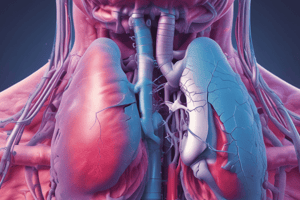Podcast
Questions and Answers
What is respiratory acidosis?
What is respiratory acidosis?
Respiratory acidosis is a clinical disorder in which the pH is less than 7.35 and the PaCO2 is greater than 45 mm Hg.
Briefly explain the pathophysiology of respiratory acidosis.
Briefly explain the pathophysiology of respiratory acidosis.
It occurs due to inadequate excretion of CO2, leading to elevated plasma CO2 concentrations and increased levels of carbonic acid, along with decreased PaO2.
In what type of conditions does respiratory acidosis occur?
In what type of conditions does respiratory acidosis occur?
It occurs in situations like acute pulmonary edema, aspiration of foreign objects, atelectasis, and severe COPD, among others.
List some clinical manifestations of respiratory acidosis.
List some clinical manifestations of respiratory acidosis.
What symptoms can an elevated PaCO2 greater than 60 mmHg cause?
What symptoms can an elevated PaCO2 greater than 60 mmHg cause?
What heart rhythm may be the first sign of respiratory acidosis in anesthetized patients?
What heart rhythm may be the first sign of respiratory acidosis in anesthetized patients?
What can begin to occur if respiratory acidosis is severe?
What can begin to occur if respiratory acidosis is severe?
How does respiratory acidosis affect potassium and hydrogen ion concentration?
How does respiratory acidosis affect potassium and hydrogen ion concentration?
What diseases can cause chronic respiratory acidosis?
What diseases can cause chronic respiratory acidosis?
Why is oxygen used very cautiously in patients with long-term COPD?
Why is oxygen used very cautiously in patients with long-term COPD?
Explain the ABG of respiratory acidosis.
Explain the ABG of respiratory acidosis.
What is the treatment for respiratory acidosis?
What is the treatment for respiratory acidosis?
How are bronchodilators used to treat respiratory acidosis?
How are bronchodilators used to treat respiratory acidosis?
Flashcards are hidden until you start studying
Study Notes
Respiratory Acidosis
- Characterized by pH < 7.35 and PaCO2 > 45 mm Hg; can be acute or chronic.
Pathophysiology
- Caused by inadequate CO2 excretion due to poor ventilation, leading to elevated CO2 and carbonic acid levels.
- Elevated PaCO2 typically results in decreased PaO2.
Conditions Causing Respiratory Acidosis
- Acute: pulmonary edema, foreign body aspiration, atelectasis, pneumothorax, sedative overdose.
- Non-emergent: sleep apnea with obesity, severe pneumonia, acute respiratory distress syndrome.
- Common in patients with severe COPD, especially during respiratory infections or heart failure.
- Associated with diseases impairing respiratory muscles (e.g., scoliosis, muscular dystrophy, multiple sclerosis).
Clinical Manifestations
- Symptoms include tachycardia, increased blood pressure, elevated respiratory rate, confusion, disorientation, and decreased consciousness levels.
Effects of Elevated PaCO2
- PaCO2 > 60 mm Hg leads to cerebrovascular vasodilation and increased cerebral blood flow.
Anesthetic Considerations
- Ventricular fibrillation may be the initial sign of respiratory acidosis in anesthetized patients.
Severe Respiratory Acidosis
- Increased intracranial pressure may occur, leading to papilledema and dilated conjunctival blood vessels.
Potassium and Hydrogen Ion Concentration
- Acidosis results in hyperkalemia as hydrogen ions shift into cells, causing potassium to move into the bloodstream.
Chronic Respiratory Acidosis
- Associated with diseases like COPD (emphysema, chronic bronchitis), obstructive sleep apnea, and obesity.
- Symptoms may not develop unless PaCO2 rises quickly; prolonged conditions allow the body to adapt.
Oxygen Use in Long-term COPD
- Caution is necessary as chronic hypercapnia may desensitize the respiratory center to CO2, relying on hypoxic drive to breathe.
- High oxygen concentrations can eliminate hypoxic stimulus, risking respiratory failure.
Arterial Blood Gas (ABG) Analysis
- ABG in respiratory acidosis shows pH < 7.35, PaCO2 > 45 mm Hg; bicarbonate levels vary by condition duration.
Treatment Approaches
- Focus on enhancing ventilation for acute and chronic respiratory acidosis.
- Treatment specifics vary based on the cause of inadequate ventilation.
Role of Bronchodilators
- Bronchodilators are utilized to reduce bronchial spasms and improve ventilation.
Studying That Suits You
Use AI to generate personalized quizzes and flashcards to suit your learning preferences.




